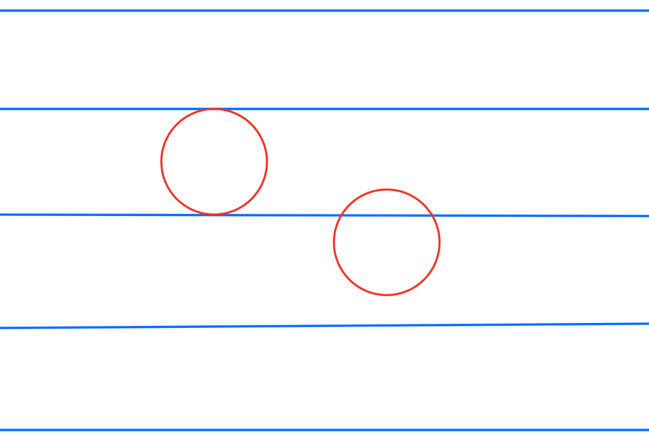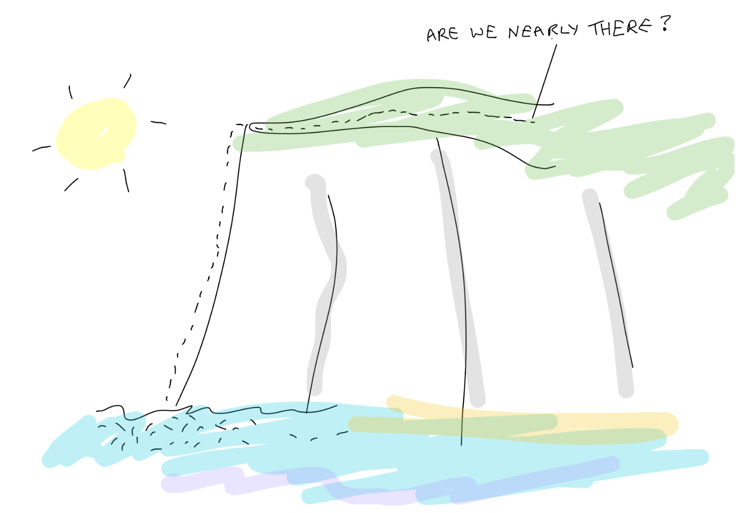It was a philosophical chicken, pushing the boundaries of free will.
Personal Blogs
"Everyone to the front of the ship and admire the figurehead I designed", said Tom _______
Sadly my Uncle gambled his wife away. He was playing Poker, and she was the Ante.
Linearity of Expectation can pop in surprising places.
Buffon's
needle is a famous experiment first published by the Comte de Buffon in
1777. His idea was to repeatedly throw a short needle on to an array of
equally spaced parallel lines and count how often the needle crossed a
line. This can then be used to estimate the value of the famous number π, a rather
surprising fact.
Suppose
the lines are spaced 1 unit apart and the needle is of length L less
than 1, so the needle will cross at most one line. Then it can be shown
the average number of crossings is 2 x L/π.
The standard way to work this out uses calculus, but reading around Linearity of Expectation I came a cross a far simpler way.
In the sketch below the circles
are of diameter 1 and you can see that a circle however
positioned will have exactly 2 points in common with the array of
paralle lines.

So we can say immediately that the expected number of
crossings when a circle is placed on the array of parallel lines is 2.
Now imagine replacing the circle with a polygon made up of many tiny needles each of identical length L. The polygon will only be an approximate circle, but if the needles are very short the approximation will be good.
Given the circle has diameter 1 its circumference will be π x 1 = π and the approximating polygon will require π / L needles. Suppose we define an indicator which is 1 if a given needle crosses a line and 0 otherwise. Let the expected value of this indicator variable be E. This is the same for all the needles; it represents the average number of crossings, not the actual number of crossing by any particular needle.
Using linearity of expectation and adding this expectation E across all the π / L needles we get E x π / L and this must be the expected number of crossing for the circle, because the needles taken together make up the circle! So E x π / L = 2.
Rearrange this slightly and voilà! - we have Buffon's formula.
E = 2 x L / π
This extremely neat and simple approach was found by Barbier as long ago as 1860 but I only stumbled across it a couple of days back.
We need to do a little more work before we have a complete proof, because we've assumed L is very small. What if it's not? I'll add something in the comments about this.
I wasn’t very successful as a judge. I think I was trying too hard.
Mr and Mrs Namik had a daughter. What was she called?
__
(See for https://learn1.open.ac.uk/mod/oublog/viewpost.php?post=201853 for the origin of this formula.)
“Please forgive me Admiral Nelson, but we’ll have to amputate”, Tom the ship’s surgeon said —————-
"When can the doctor see me? I've been waiting here for hours" said Tom _________
The question at
https://learn1.open.ac.uk/mod/oublog/viewpost.php?post=221531
asked for the average, i.e. the mean, number of letters that would be left unchanged in position if the letters of 'Dermatoglyphics' are scrambled at random. The answer is 1 and surprisingly, to me anyway, the answer would be exactly the same for any other word with no repeated letters, whatever its length. Even though I know why this is it still amazes me, it seems to go against intution.
Albert Camus once said an intellectual is a person who watches themselves thinking.
It's just occurred to me that this means he was a philosopher watching others watching themselves thinking.
So where do we stand on this?
Is there an insect called the Must Fly?
Time is such a fragile beauty.
As soon as the wind blows
Its delicate membranes are tugged apart.
Beware cut-price Velcro. It’s a rip-off.
Last night raiders struck the Scrabble factory and made off with all the J’s and L’s. Luckily the police are on the K’s.


I tried pyramid selling. But no one wants pyramids these days.
I don’t get flat-earthers. I mean it’s not, there’s hills and stuff.


Who would have thought
That cyclamens would come so early?

Reader: I had an affair with a star. But it wasn’t Sirius.
I went to the doctor, I said "Doctor, I keep thinking I'm a pile of pebbles on a beach somewhere".
She said "Are you sure?"
The word 'dermatoglyphics' refers to the study of patterns on the skin. It's of interest to word-puzzle enthusiasts (as well detectives; think fingerprints) because at 15 letters it weighs in as one of the longest words in English with no repeated letters.
Imagine we scramble the letters completely at random, to get an anagram: for example 'eymrsopahcdgtli'. Suppose we try many of these anagrams and count the number of letters that are in the same position as they were in the original 'dermatoglyphics'. The count can be anything from 0 to 13, or 15. What will its average value be?
Good news. For my work in the physics of closely-compacted ice-crystal spheres I’ve been awarded the Snowball Prize.
This blog might contain posts that are only visible to logged-in users, or where only logged-in users can comment. If you have an account on the system, please log in for full access.